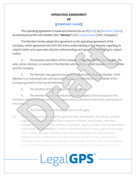A Step-by-Step Guide to Crafting Your Consulting/Coaching Policy
Running a sustainable consulting or coaching business means dealing with multiple moving parts. One key aspect of this infrastructure that often...
6 min read
LegalGPS : Jul. 26, 2024
You've decided to use your knowledge and passion to help others as a coach. That's awesome! But to make sure your coaching relationship works as smoothly as possible, you'll need an effective coaching agreement. In this article, we'll guide you through what a coaching agreement is, why it’s crucial, how to write one, and why our professionally-crafted contract templates could be the perfect tool for you.

Legal GPS templates are drafted by top startup attorneys and fully customizable.
A coaching agreement is a customized contract between you, as the coach, and your client. It serves as the foundation of your coaching relationship, covering essential details like services to be provided, expectations, boundaries, and confidentiality. A well-crafted coaching agreement ensures both parties understand their roles and responsibilities, paving the way for a smooth and productive coaching experience. In this guide, we'll walk you through each aspect of the coaching agreement so you can craft a comprehensive document with ease.
The Components of a Coaching Agreement
Services and Scope: Clearly define the specific coaching services you'll offer (e.g., life coaching, business coaching) and mention any limitations or exclusions. Ensure the scope of your services is straightforward so your client knows exactly what to expect.
Action tip: List your services in bullet points and avoid ambiguous language that could lead to misunderstandings.
Roles and Responsibilities: Outline the roles and responsibilities of both the coach and the client. This helps set expectations and avoid potential conflicts or disagreements.
Action tip: Use separate sections for the coach's and client's roles. Clearly state what each party is expected to do (e.g., provide guidance, be punctual, commit to the process).
Goals and Milestones: Specify the client's overall goals for the coaching relationship, as well as any agreed-upon milestones or action plans.
Action tip: Collaborate with your client to establish specific, measurable, achievable, realistic, and time-bound (SMART) goals. This sets a clear direction for the coaching journey.
Schedule and Session Format: Indicate how often you'll meet with your client, how long each session will be, and the mode of communication (e.g., in-person, phone, video conference).
Action tip: Build a schedule that is flexible and accounts for any modifications in meeting times, while emphasizing the importance of consistency.
Fees and Payment Terms: Clearly state your pricing, payment schedule, and accepted methods of payment. Additionally, outline your policies on late payments, cancellations, and refunds.
Action tip: Provide a comprehensive breakdown of costs, including any additional fees for supplementary materials or services.
Confidentiality and Privacy: Emphasize your commitment to protecting your client's personal information and maintaining their confidentiality throughout the coaching process.
Action tip: Specify the situations (if any) under which you may share a client's information with third parties, such as for legal reasons or in consultation with another professional for the client's benefit.
Termination and Amendments: Include procedures for terminating the coaching agreement and amending its terms, should the need arise.
Action tip: Offer a clear process for discussing revisions to the agreement and outline conditions for termination (e.g., with a certain amount of notice, under specific circumstances).
Dispute Resolution: Incorporate a clause that outlines how any disagreements or disputes will be handled (e.g., mediation, arbitration, litigation).
Action tip: Consult with an attorney to ensure that your dispute resolution clause protects the interests of both parties.
Signatures and Dates: Conclude the agreement with spaces for both parties to sign and date the document, signaling their consent to its terms.
Action tip: Keep a signed copy for your records and provide one to your client as well.

Just as a map guides you on an unfamiliar road, a coaching agreement provides structure and clarity in the coaching journey. It eliminates uncertainties, prevents any future conflict, and ensures trust. So, just like you wouldn’t go on that road trip without checking your GPS, don’t start your coaching relationship without an agreement in place!

Protect your business with our complete legal subscription service, designed by top startup attorneys.
Exactly like a map with different points guiding you to your destination, a coaching agreement contains several elements:
Creating an effective coaching agreement can be broken down into simple, actionable steps. Follow this detailed guide and you'll be on your way to crafting a contract that sets the stage for success in your coaching relationship:
Start by stating the purpose of the coaching agreement. Describe the specific service you'll provide, such as life coaching, career coaching, or business mentoring. This helps clarify the scope of the agreement and ensures your client has a clear understanding of the focus area.
Action tip: Be as specific as possible in describing your coaching services, and try to avoid over-promising by highlighting any limitations in your expertise.
Clearly outline the responsibilities of both the coach and the client. For example, as a coach, you may be responsible for guiding and supporting the client, providing timely feedback, and maintaining confidentiality. As a client, they should be open to receiving feedback, complete assigned tasks, and actively participate in the coaching process.
Action tip: Use bullet points to list the roles and responsibilities of each party, concentrating on what is expected in terms of communication, punctuality, and overall behavior.
Establish clear objectives for the coaching relationship. This typically includes the client's goals, broadly categorized (personal development, professional growth, business management, etc.) and any specific milestones you both agree to work towards.
Action tip: Encourage the client to create specific, measurable, achievable, realistic, and time-bound (SMART) goals to serve as a foundation for the coaching process.
Outline the expected duration of the coaching relationship, as well as the frequency and length of your coaching sessions. Define the start date, end date, and preferred mode of communication (in-person, phone, video conference, etc.).
Action tip: Emphasize the importance of maintaining a consistent schedule, but also provide room for flexibility in case either party needs to reschedule a session.
Clearly state your fee structure, including any costs for additional coaching resources (such as assessments or books). Specify the payment schedule (e.g., per session, monthly) and preferred payment methods (cash, bank transfer, credit card, etc.). Establish your late payment and cancellation policies, detailing any applicable fees or penalties.
Action tip: Make sure your payment terms are fair and transparent to avoid any potential confusion or disputes down the line.
Clearly state your commitment to maintaining client confidentiality and ensuring the privacy of their personal information. Also, outline your intellectual property policies, specifying who owns any materials, concepts, or strategies generated during the coaching process.
Action tip: Specify the circumstances (if any) under which information might be shared with third parties, such as for legal reasons or with another professional to better serve the client.
Specify the conditions under which the coaching agreement can be terminated by either party. Clarify how many days' notice is required, and any applicable fees or refunds. Additionally, include a provision that allows for the amendment of the agreement in the future, detailing the process for making changes.
Action tip: Provide a clear process for reviewing and amending the agreement during the coaching relationship (e.g., after a specific time frame, upon reaching a milestone, etc.).
Include a clause that outlines how disputes will be resolved, should any arise during the coaching relationship. Both parties should agree on a method such as mediation, arbitration, or court litigation to handle any conflicts.
Action tip: Consult with an attorney to ensure you have an appropriate dispute resolution clause that protects both parties' interests.
Finally, be sure to include spaces for signatures and dates from both parties, signifying their consent and agreement to the terms and conditions laid out in the coaching agreement.
Action tip: Keep a signed copy of the coaching agreement for your records and provide the client with a copy as well.
By following these steps, you'll have crafted a comprehensive coaching agreement that sets the stage for a successful and positive coaching experience!
Remember, precision and understanding are key. Avoid jargon and keep the language simple and understandable.
Get Your Coaching Agreement Template
with a Legal GPS Subscription
A good coaching agreement provides clarity, so avoid ambiguity. Be specific about your roles, the services you provide, and what you don’t provide. Don’t forget to include how disagreements will be resolved and how the agreement can be revised in the future.
Avoid the following mistakes when writing a coaching agreement:
Not defining your roles and responsibilities.
Being vague about what services you will provide.
Not being clear about what you won’t provide.
Not including how disagreements will be resolved.
Failing to include how the agreement can be revised in the future.
Always personalize your contract. One-size-fits-all rarely works well in coaching. Also, get your agreement reviewed by an attorney. It might seem like an unnecessary expense, but you’ll thank yourself later. The best coaching agreements are focused on results. They detail what the client wants to achieve and how much time they’ll have with you. It can also be helpful to include a clause that stipulates what happens if either party terminates the agreement early.
Finally, make sure to set up some kind of payment system. Most clients prefer to pay by the session or as they go.
Why use our contract templates? Well, they’re already set up with all the components you need, making it easier than ever to create a comprehensive and legally-sound coaching agreement. They're customizable to your specific needs, and best of all, they're drafted by professionals acquainted with legal tangles of the coaching world.
So, next time you sit for a coffee chat with a potential client, don’t fret about how to pitch or explain your services. Let our agreement do the talking for you, letting you focus on forming a relationship based on trust, comfort, and a shared understanding from the go.
Writing a coaching agreement might seem daunting, but it doesn’t have to be. With the right understanding and resources, it becomes a valuable tool that can lead to a successful coaching relationship. We hope this guide helps you create a robust coaching agreement, and remember, our professionally crafted coaching contract templates are always here to help you in this journey. So focus on what you do best, transforming lives, while we help you keep the legal side of things in check.
Ready to create an effective coaching agreement? Get your professional coaching agreement template here!
Get Legal GPS's Coaching Agreement Template Now

Protect your business with our complete legal subscription service, designed by top startup attorneys.

Running a sustainable consulting or coaching business means dealing with multiple moving parts. One key aspect of this infrastructure that often...

Running a successful business is all about staying on top of your game—and that includes being able to navigate legally complex situations with ease....

Have you ever been in a photoshoot and wondered how to manage things legally, to ensure you are adequately protected while also protecting the rights...